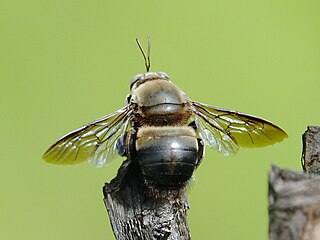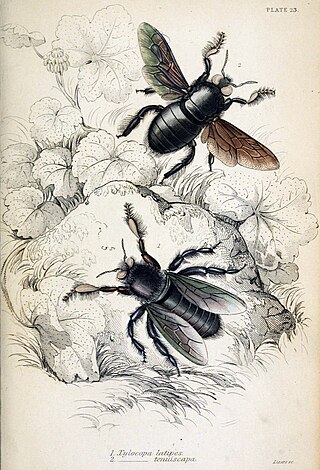
Rhododendron ponticum, called common rhododendron or pontic rhododendron, is a species of flowering plant in the Rhododendron genus of the heath family Ericaceae. It is native to the Iberian Peninsula in southwest Europe and the Caucasus region in northern West Asia.

The genus Agapostemon is a common group of Western Hemisphere sweat bees.
The Catalogue of Life is an online database that provides an index of known species of animals, plants, fungi, and microorganisms. It was created in 2001 as a partnership between the global Species 2000 and the American Integrated Taxonomic Information System. The Catalogue is used by research scientists, citizen scientists, educators, and policy makers. The Catalogue is also used by the Biodiversity Heritage Library, the Barcode of Life Data System, Encyclopedia of Life, and the Global Biodiversity Information Facility. The Catalogue currently compiles data from 165 peer-reviewed taxonomic databases that are maintained by specialist institutions around the world. As of September 2022, the COL Checklist lists 2,067,951 of the world's 2.2m extant species known to taxonomists on the planet at present time.

The Labeninae is a subfamily within the parasitoid wasp family Ichneumonidae. The family is divided into 12 extant genera grouped within four tribes.
Anthidium latum is a species of bee in the family Megachilidae, the leaf-cutter, carder, or mason bees.
Species 2000 is a federation of database organizations around the world that compiles the Catalogue of Life, a comprehensive checklist of the world's species, in partnership with the Integrated Taxonomic Information System (ITIS). The creation of Species 2000 was initiated by Frank Bisby and colleagues at the University of Reading in the UK in 1997 and the Catalogue of Life was first published in 2001. While administrators and member organizations of Species 2000 are located around the world, the secretariat is located at the Naturalis Biodiversity Center in Leiden, Netherlands.

Xylocopa caerulea, the blue carpenter bee, is a species of carpenter bee.

The genus Systropha comprises several species of Old World sweat bees, primarily specialist pollinators of plants in the genus Convolvulus. Males of the genus have unusual curled antennae, and females have pollen-carrying hairs covering almost the entire abdomen.

Xylocopa aestuans, or Xylocopa (Koptortosoma) aestuans, is a species of carpenter bee. It is widely distributed in Southeast Asia.
Xylocopa amethystina, or Xylocopa (Nodula) amethystina, is a species of carpenter bee. It is distributed in South Asian countries such as, India, Pakistan and Sri Lanka.

Xylocopa auripennis, or Xylocopa (Biluna) auripennis, is a species of carpenter bee. It is widely distributed in South Asian countries, and Southeast Asian countries.
Xylocopa bryorum, or Xylocopa (Koptortosoma) bryorum, is a species of carpenter bee. It is distributed in Sri Lanka, Maldives, Bangladesh, Laos, Vietnam, Thailand.

Xylocopa dejeanii, or Xylocopa (Zonohirsuta) dejeanii, is a species of carpenter bee. It is widely distributed in Asian countries.
Xylocopa nigrocaerulea, or Xylocopa (Biluna) nigrocaerulea, is a species of carpenter bee.
Xylocopa ruficornis, or Xylocopa (Koptortosoma) ruficornis, is a species of carpenter bee. It is found in the Sri Lankan.

Xylocopa tenuiscapa, or the slender-scaped carpenter bee, is a species of carpenter bee found only in South Asian and Southeast Asian countries.
Xylocopa tranquebarica, or Xylocopa (Nyctomelitta) tranquibarica, is a species of carpenter bee. It is found only in South Asian and Southeast Asian countries. It is a nocturnal bee.

Triepeolus is a genus of cuckoo bees in the family Apidae. There are at least 140 described species in Triepeolus. The majority of species whose life history is known are kleptoparasitic in the nests of bees in the tribe Eucerini, especially the genera Melissodes and Svastra.
Bombylius albicapillus is a species of bee flies in the family Bombyliidae.
Anthodioctes camargoi is a species of bee discovered in 1999. No subspecies are listed at the Catalogue of Life.









